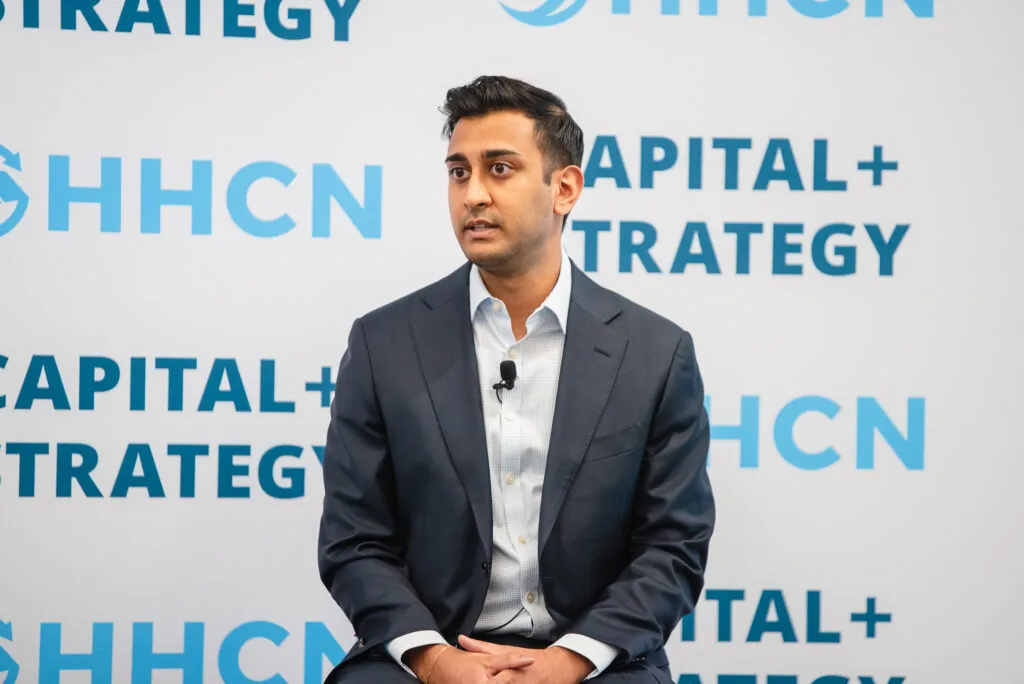
This article is a part of your HHCN+ Membership
Inflation reaching multi-decade highs, uncertainty in the banking world and credit markets drying up dampened private equity health care M&A activity in 2022, especially in the second half. Many anticipate that investment slowdown to continue into 2023, but there’s a good chance the home health industry will buck that trend.
Multiple PE firms, such as Shore Capital Partners, Health Enterprise Partners (HEP) and Sheridan Capital Partners, appear to believe that notion at least.
“Pair massive whitespace with a fragmented market, and it’s kind of the perfect space for a private equity firm like Shore Capital that follows a buy-and-build strategy to enter into,” Ankeet Patel, a vice president at the Chicago-based Shore Capital, said at the Home Health Care News Capital + Strategy conference last month.
There are several reasons why private investors will pump more money into home health purchases in 2023, but three main ones stand out to me:
– As U.S. health care spending grows unsustainable, payers of all types will lean further into care-setting optimization.
– Despite immediate labor and reimbursement challenges, demographic trends and consumer preferences will put home health services in increasingly high demand for years to come.
– The fragmented market will appeal to veteran home health investors seeking to drive value in their existing portfolios via tuck-in acquisitions, but, with valuations normalizing, it will also attract new PE players exploring buy-and-build strategies for the first time.
Shore, which typically makes platform investments in the range of $1 million to $10 million in EBITDA, is an example of that third point. The firm’s current health care portfolio includes Behavioral Innovations, BrightView and Community Care Partners, but it’s “actively looking for home health investments,” according to Patel, who also noted Shore’s interest in private-duty home care.
“We were on the sidelines for the past few years because we didn’t like the way valuations were going,” he said. “We’re really interested in Medicare-certified home health businesses and also private-duty because you can control your own destiny a little bit and mitigate some of the margin pressures through pricing power.”
I explore private equity’s home health outlook as part of this week’s exclusive, members-only HHCN+ Update. In addition to conversations from HHCN’s Capital+Strategy event, I pull from McGuireWoods’ 19th Annual Healthcare Private Equity and Finance Conference, Bain & Company’s recently released PE and M&A report, and my own on-background discussions with sources.
What they’re saying about PE in health care
Private equity investors were active in just about every corner of the health care world in 2022, but provider deals accounted for nearly half of all deal volume and value, according to Bain & Company.
Overall, deal activity in 2022 fell off slightly compared to 2021’s record-high numbers. The year actually started off at a similar breakneck pace, with first-quarter activity almost on par with Q1 2021. From there, dealmaking volume declined steadily.
“Buyout volume fell by more than 35% in the second half of 2022 compared with the first half of the year, and the fourth quarter had the lowest quarterly [health care private equity] deal activity since 2017,” Bain & Company wrote in its report.
Some of the factors triggering that slowdown – elevated inflation, unfavorable credit markets and even the war in Ukraine – persist. As a result, many are projecting a relatively quiet year for PE health care M&A activity in 2023.
Yet I’m not so sure.
I see private equity staying active in health care this year because, even with all the challenges and uncertainty, most investors were able to secure strong returns in 2022. On top of that, firms still have billions of dollars that they need to put to use – or give back.
Citing data from Preqin, Bain & Company highlighted in its global M&A report that firms raised more than $15 billion in new buyout capital for funds where health care is the sole or main focus. That, according to Bain, has happened in only two other years – 2019 and 2021 – in the last two decades.
And again, due to the industry’s long-term drivers, there’s even more reason to believe PE buyers will turn to home health care this year.
Lowering costs
National health care spending is out of control, particularly considering the nearly across-the-board poor outcomes the U.S. sees compared to other countries.
In 2021, the most recent year in which all the numbers are in, health care’s share of the economy accounted for 18.3%. That’s slightly lower than the 19.7% share in 2020, largely because of the phasing out of certain public health emergency (PHE) financial lifelines.
Within health care’s slice of the pie in 2021, Medicare accounted for 21% of national health care spending, at about $900.8 billion. In order to rein in expenditures, budget hawks will continue to brainstorm ways of cutting fat in Medicare – and shifting beneficiaries into the lowest-cost setting by strengthening home health services will be an important part of that.
Private equity sponsors are certainly aware of the government’s support of home health providers. PE investors are likewise aware that private payers – health care giants such as UnitedHealth Group (NYSE: UNH) and Humana (NYSE: HUM) – are increasingly focused on the home to lower total cost of care.
Pete Tedesco, a managing partner with HEP, spoke about that very topic at McGuireWoods’ 19th Annual Healthcare Private Equity and Finance Conference in early March. Among HEP’s investments is Jet Health, a Fort Worth, Texas-based home health, hospice and personal care provider that operates in Colorado, Idaho, New Mexico and Texas.
“I pick up on … the concept of taking costs out of the system. One of the themes we have a slightly fancy name for is getting care-setting optimization,” Tedesco said. “A lot of that is pushing care into the home.”
There’s plenty of evidence to back that up.
In a 2019 study, for example, a group of patients who were first treated in a home-based setting were significantly less likely to be admitted or readmitted to the hospital. Similarly, those patients had fewer visits to the emergency room than those admitted to the hospital.
And if the home health expansion legislation Choose Home were enacted, it would generate as much as $247 million in annual savings to the Medicare system, according to health economics firm Dobson DaVanzo & Associates.
“A lot of that is pushing care into the home.”
– Pete Tedesco, a managing partner with HEP, speaking about care-setting optimization
Demographic trends
By 2040, about one in five Americans will be 65 or older, which is up from about one in eight in 2000, according to statistics from the Urban Institute. The U.S. is already starting to feel the strain of about 10,000 baby boomers turning 65 every day, but over the next several years, America’s aging population will hit the U.S. economy like a ton of bricks.
Those figures, plus the fact that the vast majority of older adults prefer to receive care in their own homes, is something PE investors can’t ignore.
“There are favorable demographic trends in the aging population that’s only going to keep getting older,” Shore’s Patel said. “Pair that with home-based settings being cost-effective and the preferred setting for people that receive care, and that creates a lot of opportunity.”
In some ways, demand for home health services is almost so high that it’s a problem, as it has left providers with a shortage of labor. Staffing pressures have already caused some investors to cool on home health care, previous HHCN reporting suggests.
But forward-looking firms such as Shore aren’t discouraged by that, Patel explained at the Capital+Strategy conference. It just makes retention and technology a more important consideration.
“Recruiting, retention, labor utilization, all those things are in the back of our minds, as well as wage inflation and a [somewhat] negative reimbursement environment, putting pressure on margin,” he said. “We think all those things can be overcome with scale and by making the right investments in technology.”
As demand for hospital-at-home and other higher-acuity care models increases beyond the PHE, that, too, will continue to attract PE interest to home health care, which often plays a critical role in such designs.
“I think the home setting is so interesting,” Sean Dempsey, a partner with Sheridan Capital Partners, said at the McGuireWoods event. “I mean, you’ve gotten a multi-decade wave behind you that’s been going on for an extended period of time now, just accelerated by the pandemic, right? We’re all talking about the hospital-at-home and SNF-at-home concepts.”
SimiTree is among Sheridan’s portfolio companies.
Plenty of whitespace
Broadly, the factors that depressed health care PE dealmaking in the back half of last year will prompt some firms to pivot toward smaller deals, which may be less daunting from financing or equity perspectives.
What industry is still made up of thousands of high-quality mom-and-pop providers, many of which have dreams of scaling their business to a more regional size? Home health care.
“I see it as a pretty active market,” Kevin Colman, president and CEO of Home Healthcare Solutions Company, recently told HHCN. “It may be a little bit slower as we speak today just because of the overall financial environment and with interest rates a little bit higher, but I’ve been approached by a couple of private equity firms in the past who have expressed interest.”
Similar to Shore, more PE firms this year will recognize an opportunity to jump into the home health action with buy-and-build strategies, I believe. While attending recent HHCN events and external conferences, I’ve chatted with multiple PE stakeholders who effectively said as much – and I know of at least one interesting PE-backed platform that will be unveiled in the not-too-distant future.
For investors already in the space, the market’s fragmented nature still presents ample opportunities for tuck-ins.
“As investors look inward to drive value in their existing portfolios, 2023 may be the year of tuck-in acquisitions,” Bain & Company noted in its report.
Companies featured in this article:
Health Enterprise Partners, Sheridan Capital Partners, Shore Capital Partners




